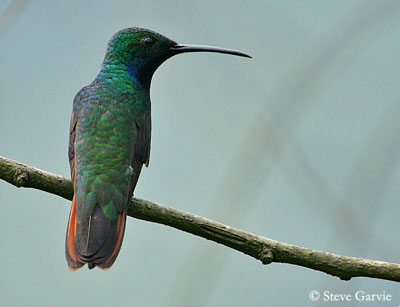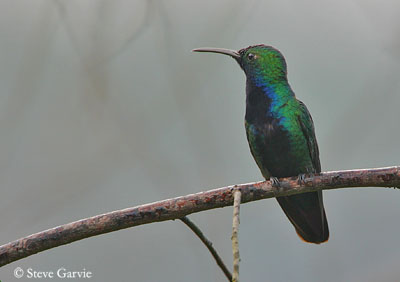
Black-throated Mango
Anthracothorax nigricollis
Apodiforme Order – Trochilidae Family
BIOMETRICS:
Length: 11-12 cm
Weight: M: 6-7 g – F : 7,3 g
LONGEVITY: Up to 8 years
DESCRIPTION: Black-throated Mango is a hummingbird of South America.
Adult male has glossy bronze-green upperparts. Flight feathers are brownish-green. Tail shows bronze-green central feathers, chestnut and purple outer tail feathers, glossed purple.
On the underparts, the centre of breast and belly is black, bordered with glossy blue on throat and breast sides. Body sides and flanks are glossy bronze-green.
Head is bronze-green on forehead, crown and nape. Chin is black, bordered by glossy blue malar stripe. The black bill is slightly down curved. Eyes are dark brown. Legs and feet are blackish.
PROTECTION / THREATS / STATUS:
Black-throated Mango is common in urban parks and in cultivated areas.
This species is not threatened at this moment.
Fr: Mango à cravate noire
All : Schwarzbrust-Mangokolibri
Esp : Mango Gorginegro
Ital : Mango collonero
Nd : Zwartkeelmango
Russe : Черногорлый колибри-манго
Photographs by Steve Garvie
His website : RAINBIRDER Photo galleries
Photographs by Patrick Ingremeau
His website : TAMANDUA
Text by Nicole Bouglouan
Sources :
HANDBOOK OF THE BIRDS OF THE WORLD Vol 5 by Josep del Hoyo-Andrew Elliott-Jordi Sargatal - Lynx Edicions - ISBN: 8487334253
A GUIDE TO THE BIRDS OF COLOMBIA by Steven L. Hilty and William L. Brown
Princeton University Press – ISBN 069108372X
Wikipedia (Wikipedia, The Free Encyclopedia)

Female has similar upperparts. On the underparts, we can see a black central stripe, from chin, though throat and breast, to belly. This black stripe is widely bordered with white on the sides.
The tail shows bronze-green central tail feathers, with black tips. Outer rectrices are deep chestnut, with purplish subterminal band, and narrow white tips.
Immature resembles female, with brown edges on head and back, and irregular brown patches on throat and breast sides. It can breed at about two years old.
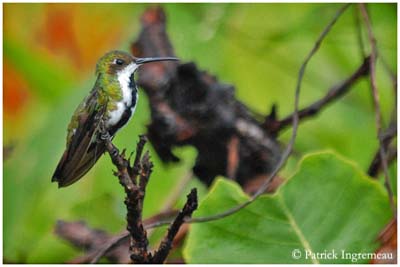
VOICE: SOUNDS BY XENO-CANTO
Black-throated Mango utters sharp, high-pitched “tsick” or “tiuck”.
The song is a series of seven buzzing notes “hsl-hsl-hsl-hsl-hsl-hsl-hsl”.
HABITAT:
Black-throated Mango lives in forest edges, clearing with bushes and scattered trees, open country, cultivated areas in mountain slopes and gardens.
It is usually seen fairly close to water in tropical areas, up to 1000 metres of elevation.
RANGE:
Black-throated Mango lives from Panama, southwards to north-eastern Bolivia, the Guianas, southern Brazil and northern Argentina, Trinidad and Tobago.
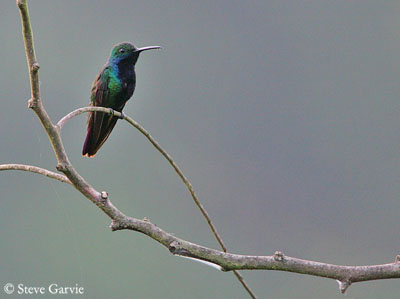
BEHAVIOUR:
Black-throated Mango feeds mainly on nectar from flowering trees, but it also catches insects. It hunts for invertebrates above the treetops and among vegetation. It performs hovering for catching flying insects in open country.
The male occupies and defends feeding areas in flowering trees. It is often solitary and may become aggressive at nectar sources. For that, it perches high in exposed branches, close to its feeding territory. It defends the area by vocal warning signals and flights. If the intruder persists, it is strongly attacked in flight by the owner with sometimes physical contact. Both birds may be locked with claws and tumble to the ground.
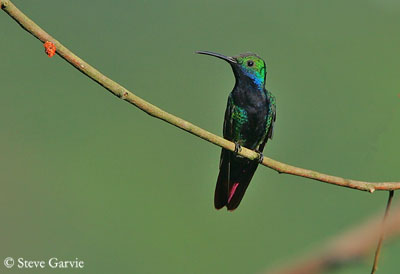
Black-throated Mango feeds mainly at dawn and dusk, and it rests on a branch during the day, in order to accumulate energy for its hovering flights.
Black-throated Mango migrates to higher altitudes in August-September. In eastern Brazil, birds perform long-distance migrations according to the food resources at flowering trees.
Courtship displays are similar to the defence displays, with the male singing from exposed perch and brief interaction between both mates during short periods, in order to fertilize the eggs.
FLIGHT:
Black-throated Mango is known for its hovering “helicoptering” flights. This bird is able to fly forwards, backwards and sideways. It is an excellent flier, but this kind of movements costs a lot of energy, and it has to feed at least three times its weight per day.
REPRODUCTION:
Breeding season occurs from December to July.
Male is polygamous and mates with several females. It does not take part in nesting duties.
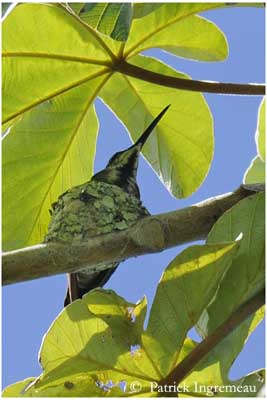
The nest is situated on horizontal bare branch, at about 8 to 15 metres above the ground. The tiny nest is built by the female. It is cup-shaped, made with fine vegetal materials such as seed down, with outside decoration of lichens and moss, dead leaves and rootlets.
Female usually lays two white eggs. Incubation lasts about 16 to 18 days, by female alone.
Chicks are blackish at hatching. They are fed by the female, with nectar and insects regurgitated directly into their crops.
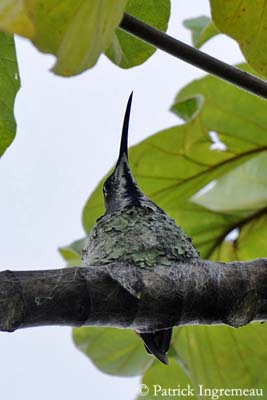
Young fledge about 20 to 24 days after hatching, but they remain with the female for 3 to 4 weeks more. They are still fed by mother, but they do not follow her when foraging. They remain in a particular place where she feeds them. They follow her when they are able to fly well, about 5 to 6 days after fledging.
This species produces two broods per season.
DIET:
Black-throated Mango feeds mainly on nectar from flowers of tall trees such as Erythrina, Tabebuia and Spathodea. It also feeds at vines, shrubs and flowering bushes.
It also consumes insects caught in flight high above treetops.
